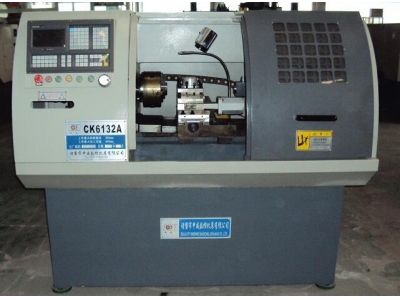一、公文對(duì)結(jié)構(gòu)的要求是?
規(guī)范性公文的結(jié)構(gòu)
規(guī)范性公文,如章程、條例、規(guī)定、規(guī)則等,在結(jié)構(gòu)方式上,幾乎都是條款式結(jié)構(gòu),這是規(guī)范性公文所具有的突出的嚴(yán)密性在結(jié)構(gòu)方式上的體現(xiàn)。具體說(shuō),規(guī)范性公文的結(jié)構(gòu)有以下幾點(diǎn):
(1)規(guī)范性公文從總體結(jié)構(gòu)上看,一般包括標(biāo)題、發(fā)布或通過(guò)批準(zhǔn)日期、內(nèi)容的章節(jié)、正文幾個(gè)部分。規(guī)范性公文的標(biāo)題一般由內(nèi)容和文種兩部分組成,發(fā)布或通過(guò)批準(zhǔn)的時(shí)間,一般注在文件的標(biāo)題之下,并用括號(hào)括住。
(2)規(guī)范性公文的正文結(jié)構(gòu)一般包括:制發(fā)公文的目的、依據(jù)、范圍、有關(guān)定義、主管部門(mén)、具體規(guī)范、獎(jiǎng)懲辦法、實(shí)施日期、實(shí)施程序、有關(guān)說(shuō)明等。
二、數(shù)控機(jī)床的機(jī)械結(jié)構(gòu)有哪些主要組成部分?
數(shù)控機(jī)床機(jī)械結(jié)構(gòu)的組成:
1、主轉(zhuǎn)動(dòng)系統(tǒng):主轉(zhuǎn)動(dòng)系統(tǒng)的作用是將驅(qū)動(dòng)裝置的運(yùn)動(dòng)及動(dòng)力傳給執(zhí)行件,實(shí)現(xiàn)主動(dòng)切削運(yùn)動(dòng)。
2、進(jìn)給轉(zhuǎn)動(dòng)系統(tǒng):有工作臺(tái)、刀架等。進(jìn)給轉(zhuǎn)動(dòng)系統(tǒng)的作用是將伺服驅(qū)動(dòng)裝置的運(yùn)動(dòng)和動(dòng)力傳給執(zhí)行件,實(shí)現(xiàn)進(jìn)給運(yùn)動(dòng)。
3、基礎(chǔ)支承件:包括床身、立柱、導(dǎo)軌、工作臺(tái)等。基礎(chǔ)支承件 的作用是支承機(jī)床的各主要部件,并使它們?cè)陟o止或者運(yùn)動(dòng)中保持相對(duì)正確的位置。
4、輔助裝置:包括自動(dòng)換刀裝置、液壓氣動(dòng)系統(tǒng)、潤(rùn)滑冷卻裝置等。
三、運(yùn)轉(zhuǎn)機(jī)械對(duì)工人的要求?
(1)、穿工作服并扎緊袖口。
(2)、工作時(shí)不得帶手套。
(3)、長(zhǎng)發(fā)、長(zhǎng)辮盤(pán)在帽內(nèi)。
(4)、嚴(yán)禁穿短衫、短褲、裙子、涼鞋和拖鞋。
(5)、操作人員應(yīng)接受專業(yè)的培訓(xùn)和指導(dǎo),熟悉設(shè)備的工作原理、操作規(guī)程以及安全操作程序。
四、結(jié)構(gòu)防水對(duì)砼強(qiáng)度的要求?
1、防水混凝土應(yīng)通過(guò)調(diào)整配合比摻加外加劑摻合料配制而成抗?jié)B等級(jí)不得小于S6
2、防水混凝土的施工配合比應(yīng)通過(guò)試驗(yàn)確定抗?jié)B等級(jí)應(yīng)比設(shè)計(jì)要求提高一級(jí)(0.2MPa)
3、防水混凝土的環(huán)境溫度,不得高于80℃:、處于侵蝕性介質(zhì)中防水混凝土的耐侵蝕系數(shù),不應(yīng)小于0.8.
4、防水混凝土結(jié)構(gòu)底板的混凝土墊層,強(qiáng)度等級(jí)不應(yīng)小于C15,、厚度不應(yīng)小于100mm,、在軟弱土層中不應(yīng)小于150mm.
五、機(jī)械結(jié)構(gòu)件焊接要求
機(jī)械結(jié)構(gòu)件焊接要求
機(jī)械結(jié)構(gòu)件的焊接是工程領(lǐng)域中常見(jiàn)的連接方式之一,它可以將不同的零件相互連接,并提供強(qiáng)大的結(jié)構(gòu)支撐力。為了確保焊接接縫的質(zhì)量和可靠性,我們需要遵循一些焊接要求和標(biāo)準(zhǔn)。本文將介紹機(jī)械結(jié)構(gòu)件焊接的基本要求和注意事項(xiàng)。
焊接材料選擇
在機(jī)械結(jié)構(gòu)件的焊接過(guò)程中,選擇合適的焊接材料非常重要。焊接材料應(yīng)具有與被焊接材料相似的力學(xué)性能和化學(xué)成分,以保證焊接接縫的強(qiáng)度和穩(wěn)定性。同時(shí),還需考慮到焊接材料的可焊性和耐腐蝕性。通常情況下,碳鋼、不銹鋼、鋁合金等材料是常用的焊接材料。
焊接工藝選擇
為了獲得高質(zhì)量的焊接接縫,正確的焊接工藝選擇至關(guān)重要。根據(jù)焊接材料的不同和焊接接縫的要求,可以選擇不同的焊接工藝。常用的焊接工藝包括手工電弧焊、氬弧焊、氣保焊等。在選擇合適的焊接工藝時(shí),需要考慮到焊接材料的類型、厚度和所需焊接強(qiáng)度等因素。
焊接前的準(zhǔn)備工作
在進(jìn)行機(jī)械結(jié)構(gòu)件的焊接之前,必須進(jìn)行充分的準(zhǔn)備工作,以確保焊接的質(zhì)量和安全。準(zhǔn)備工作包括以下幾個(gè)方面:
- 清潔表面:焊接前應(yīng)將焊接接頭的表面清潔干凈,除去塵土、氧化物或其他雜質(zhì),以提供良好的焊接條件。
- 預(yù)熱:對(duì)于厚度較大的機(jī)械結(jié)構(gòu)件,在焊接前需要進(jìn)行預(yù)熱,以減少焊接應(yīng)力和冷裂的風(fēng)險(xiǎn)。
- 焊接位置和固定:根據(jù)具體焊接要求,選擇適當(dāng)?shù)暮附游恢煤凸潭ǚ椒ǎ_保焊接過(guò)程中的穩(wěn)定性和安全性。
焊接質(zhì)量控制
實(shí)施嚴(yán)格的焊接質(zhì)量控制是確保焊接接縫質(zhì)量和可靠性的關(guān)鍵。以下措施可以幫助提高焊接質(zhì)量:
- 焊接參數(shù)控制:合理控制焊接電流、電壓、速度等參數(shù),避免焊接過(guò)熱或不充分。
- 焊接過(guò)程監(jiān)測(cè):通過(guò)合適的焊接檢測(cè)方法,及時(shí)發(fā)現(xiàn)和糾正焊接中的問(wèn)題,確保焊接質(zhì)量符合要求。
- 焊接質(zhì)量評(píng)估:對(duì)焊接接縫進(jìn)行質(zhì)量評(píng)估,包括焊縫形狀、焊縫連接強(qiáng)度等指標(biāo)的檢測(cè)和評(píng)定。
焊接后處理
焊接完成后,還需要進(jìn)行一些后處理工作,以提高焊接接縫的性能和外觀。常見(jiàn)的焊接后處理工作包括熱處理、除渣、打磨拋光等。這些工作可以進(jìn)一步改善焊接接縫的強(qiáng)度、表面質(zhì)量和耐腐蝕性。
安全注意事項(xiàng)
在進(jìn)行機(jī)械結(jié)構(gòu)件的焊接時(shí),務(wù)必注意安全,遵循相關(guān)的安全操作規(guī)程。以下是一些常見(jiàn)的安全注意事項(xiàng):
- 穿戴防護(hù)裝備:在焊接過(guò)程中,應(yīng)穿戴防護(hù)眼鏡、手套、防火服等,以避免受到火花、熱輻射等傷害。
- 通風(fēng)換氣:焊接過(guò)程中會(huì)產(chǎn)生有害氣體和煙塵,應(yīng)確保良好的通風(fēng)換氣,以保護(hù)操作人員的健康。
- 滅火設(shè)備備齊:在焊接現(xiàn)場(chǎng)備齊滅火器等滅火設(shè)備,以備不時(shí)之需。
通過(guò)遵循上述的機(jī)械結(jié)構(gòu)件焊接要求和注意事項(xiàng),我們可以確保焊接接縫的質(zhì)量和可靠性,提高機(jī)械結(jié)構(gòu)件的整體性能和使用壽命。在進(jìn)行任何焊接工作之前,務(wù)必了解所使用的材料和工藝,并嚴(yán)格按照相關(guān)的標(biāo)準(zhǔn)操作。
Translated to English: htmlRequirements for Welding Mechanical Structural Components
Welding is a common method of joining mechanical structural components in the field of engineering. It allows for the connection of different parts and provides strong structural support. To ensure the quality and reliability of welded joints, it is necessary to adhere to specific welding requirements and standards. This article will introduce the basic requirements and considerations for welding mechanical structural components.
Selection of Welding Materials
Choosing appropriate welding materials is crucial in the welding process of mechanical structural components. Welding materials should have similar mechanical properties and chemical compositions to the materials being welded, ensuring the strength and stability of welded joints. Weldability and corrosion resistance should also be taken into account. Commonly used welding materials include carbon steel, stainless steel, and aluminum alloys.
Selection of Welding Techniques
Selecting the correct welding technique is essential for obtaining high-quality welded joints. Different welding techniques can be used based on the welding materials and requirements of the joint. Common welding techniques include manual arc welding, tungsten inert gas (TIG) welding, and metal inert gas (MIG) welding. The choice of welding technique should consider factors such as the type and thickness of the materials being welded and the desired weld strength.
Pre-Welding Preparation
Before welding mechanical structural components, thorough preparation must be done to ensure the quality and safety of the welding process. Pre-welding preparation includes the following aspects:
- Cleaning the Surface: The welding joint surfaces should be cleaned from dust, oxide or other impurities to provide optimal welding conditions.
- Preheating: For thicker mechanical structural components, preheating is necessary to reduce the risk of welding stress and cold cracking.
- Welding Position and Fixation: Based on specific welding requirements, appropriate welding positions and fixation methods should be selected to ensure stability and safety during the welding process.
Quality Control in Welding
Implementing stringent quality control measures is crucial for ensuring the quality and reliability of welded joints. The following measures can help improve welding quality:
- Control of Welding Parameters: Proper control of welding parameters such as current, voltage, and speed helps avoid overheating or insufficient welding.
- Monitoring the Welding Process: By using suitable welding inspection methods, welding problems can be detected and rectified in a timely manner, ensuring that the welding quality meets the requirements.
- Weld Quality Assessment: Weld quality assessment involves inspecting and evaluating welding joint indicators such as weld shape and connection strength.
Post-Welding Treatment
After completing the welding process, additional post-welding treatments are often necessary to improve the performance and appearance of the welded joints. Common post-welding treatments include heat treatment, slag removal, grinding, and polishing. These treatments further enhance the strength, surface quality, and corrosion resistance of the welded joints.
Safety Precautions
When welding mechanical structural components, safety should be the top priority, and relevant safety procedures must be followed. Here are some common safety precautions:
- Wear Protective Gear: During the welding process, operators should wear protective goggles, gloves, fire-resistant clothing, etc., to avoid injuries from sparks and thermal radiation.
- Ensure Adequate Ventilation: Harmful gases and fumes are generated during welding, so proper ventilation is essential to protect the health of the operators.
- Have Firefighting Equipment Ready: Prepare firefighting equipment, such as fire extinguishers, in the welding area to be prepared for any unexpected situations.
By following the requirements and precautions mentioned above for welding mechanical structural components, we can ensure the quality and reliability of welded joints, thereby improving the overall performance and lifespan of the mechanical components. Before undertaking any welding work, it is essential to understand the materials and techniques involved and strictly adhere to relevant standards and procedures.
六、鋼結(jié)構(gòu)組對(duì)間隙要求?
鋼結(jié)構(gòu)組對(duì)間隙有要求,要求連接面的80%要接觸上。這是因?yàn)槟軌蜻_(dá)到這個(gè)要求,結(jié)構(gòu)在承受剪力的時(shí)候,接觸面的摩擦力,能夠很好的抵消剪力,這樣就能有效的保證連接的穩(wěn)定性。
不過(guò)在生產(chǎn)過(guò)程中,由于焊接變形,鋼結(jié)構(gòu)連接面的接觸面積達(dá)不到這一要求。所以生產(chǎn)中,一定要控制好焊接變形。
七、數(shù)控機(jī)床對(duì)主軸的驅(qū)動(dòng)的要求是什么?
答案,其原理是按程序要求驅(qū)動(dòng)主軸,在數(shù)控車(chē)床的加工方式中,主軸主要是帶動(dòng)工件旋轉(zhuǎn),與進(jìn)給伺服驅(qū)動(dòng)軸相配合,完成切削運(yùn)動(dòng)。
數(shù)控車(chē)床對(duì)主軸位置精度和速度調(diào)節(jié)不像要求進(jìn)給伺服系統(tǒng)那樣高,所以執(zhí)行部件多采用通用交流異步電動(dòng)機(jī),很少采用價(jià)格昂貴的永磁交流伺服電動(dòng)機(jī)。
變頻器+交流異步電動(dòng)機(jī)”進(jìn)行矢量控制、編碼器進(jìn)行速度檢測(cè)的方式,可以滿足一般精度零件加工和車(chē)削螺紋的要求,并且調(diào)速方便,造價(jià)成本相對(duì)較低,被廣泛采用。
八、人類對(duì)機(jī)械的基礎(chǔ)要求有哪些?
機(jī)械設(shè)計(jì)要求及原則:
1、技術(shù)性能準(zhǔn)則:技術(shù)性能包括產(chǎn)品功能、制造和運(yùn)行狀況在內(nèi)的一切性能,既指靜態(tài)性能,也指動(dòng)態(tài)性能。例如,產(chǎn)品所能傳遞的功率、效率、使用壽命、強(qiáng)度、剛度、抗摩擦、磨損性能、振動(dòng)穩(wěn)定性、熱特性等。技術(shù)性能準(zhǔn)則是指相關(guān)的技術(shù)性能必須達(dá)到規(guī)定的要求。
2、標(biāo)準(zhǔn)化準(zhǔn)則:與機(jī)械產(chǎn)品設(shè)計(jì)有關(guān)的主要標(biāo)準(zhǔn)大致有:概念標(biāo)準(zhǔn)化,實(shí)物形態(tài)標(biāo)準(zhǔn)化,方法標(biāo)準(zhǔn)化。標(biāo)準(zhǔn)化準(zhǔn)則就是在設(shè)計(jì)的全過(guò)程中的所有行為,都要滿足上述標(biāo)準(zhǔn)化的要求。現(xiàn)已發(fā)布的與機(jī)械零件設(shè)計(jì)有關(guān)的標(biāo)準(zhǔn),從運(yùn)用范圍上來(lái)講,可以分為國(guó)家標(biāo)準(zhǔn)、行業(yè)標(biāo)準(zhǔn)和企業(yè)標(biāo)準(zhǔn)三個(gè)等級(jí)。從使用強(qiáng)制性來(lái)說(shuō),可分為必須執(zhí)行的和推薦使用的兩種。
九、數(shù)控機(jī)床的電源要求?
國(guó)內(nèi)數(shù)控機(jī)床供電的電源電壓都是三相AC380V,50HZ . 至于數(shù)控機(jī)床內(nèi)部的主軸驅(qū)動(dòng)器,伺服驅(qū)動(dòng)器的電壓會(huì)有三相AC380V,三相AC220V的區(qū)分。
數(shù)控系統(tǒng)的供電電壓會(huì)有AC220V,或DC24V等。
機(jī)床交流控制電路會(huì)有AC220V,AC110V,等。
機(jī)床直流控制電路會(huì)一般是DC24V。
照明會(huì)有AC220V,或AC24V,或DC24V, 伺服變壓器,控制變壓器上都有電壓等級(jí)標(biāo)識(shí),可查看。
十、機(jī)械硬盤(pán)對(duì)主板有要求嗎?
機(jī)械硬盤(pán)對(duì)主板只有一個(gè)具體的要求,即主板上有一個(gè)正常的未被占用的SATA接口。
目前基本上市面上所出售的所有一二三線PC電腦主板都有SATA接口配置。
用電腦硬盤(pán)分區(qū)工具分系統(tǒng)盤(pán)/c盤(pán)和邏輯盤(pán)/d/e/f等等。c盤(pán)安裝Windows/Mac iOS/Linux操作系統(tǒng),其他盤(pán)作為數(shù)據(jù)備份。


 發(fā)布于
2024-04-29
發(fā)布于
2024-04-29